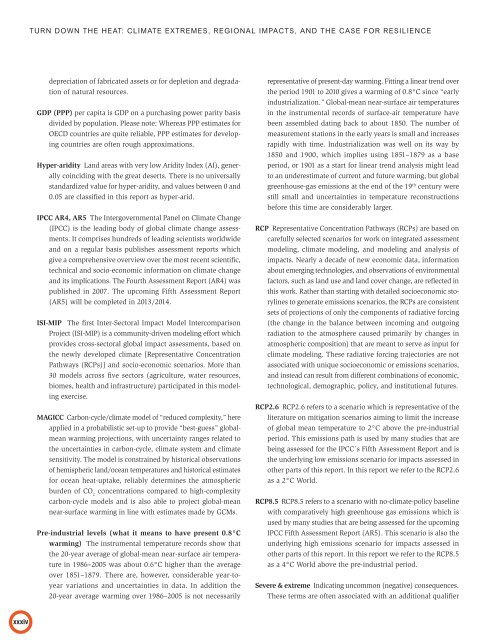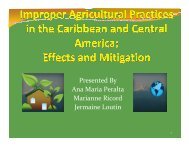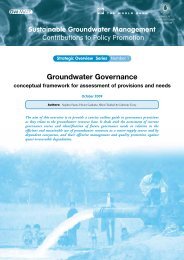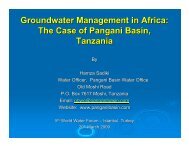You also want an ePaper? Increase the reach of your titles
YUMPU automatically turns print PDFs into web optimized ePapers that Google loves.
TURN DOWN THE HEAT: CLIMATE EXTREMES, REGIONAL IMPACTS, AND THE CASE FOR RESILIENCEdepreciation of fabricated assets or for depletion and degradationof natural resources.GDP (PPP) per capita is GDP on a purchasing power parity basisdivided by population. Please note: Whereas PPP estimates forOECD countries are quite reliable, PPP estimates for developingcountries are often rough approximations.Hyper-aridity Land areas with very low Aridity Index (AI), generallycoinciding with the great deserts. There is no universallystandardized value for hyper-aridity, and values between 0 and0.05 are classified in this report as hyper-arid.IPCC AR4, AR5 The Intergovernmental Panel on Climate Change(IPCC) is the leading body of global climate change assessments.It comprises hundreds of leading scientists worldwideand on a regular basis publishes assessment reports whichgive a comprehensive overview over the most recent scientific,technical and socio-economic information on climate changeand its implications. The Fourth Assessment <strong>Report</strong> (AR4) waspublished in 2007. The upcoming Fifth Assessment <strong>Report</strong>(AR5) will be completed in 2013/2014.ISI-MIP The first Inter-Sectoral Impact Model IntercomparisonProject (ISI-MIP) is a community-driven modeling effort whichprovides cross-sectoral global impact assessments, based onthe newly developed climate [Representative ConcentrationPathways (RCPs)] and socio-economic scenarios. More than30 models across five sectors (agriculture, water resources,biomes, health and infrastructure) participated in this modelingexercise.MAGICC Carbon-cycle/climate model of “reduced complexity,” hereapplied in a probabilistic set-up to provide “best-guess” globalmeanwarming projections, with uncertainty ranges related tothe uncertainties in carbon-cycle, climate system and climatesensitivity. The model is constrained by historical observationsof hemispheric land/ocean temperatures and historical estimatesfor ocean heat-uptake, reliably determines the atmosphericburden of CO 2concentrations compared to high-complexitycarbon-cycle models and is also able to project global-meannear-surface warming in line with estimates made by GCMs.Pre-industrial levels (what it means to have present 0.8°Cwarming) The instrumental temperature records show thatthe 20-year average of global-mean near-surface air temperaturein 1986–2005 was about 0.6°C higher than the averageover 1851–1879. There are, however, considerable year-toyearvariations and uncertainties in data. In addition the20-year average warming over 1986–2005 is not necessarilyrepresentative of present-day warming. Fitting a linear trend overthe period 1901 to 2010 gives a warming of 0.8°C since “earlyindustrialization.” Global-mean near-surface air temperaturesin the instrumental records of surface-air temperature havebeen assembled dating back to about 1850. The number ofmeasurement stations in the early years is small and increasesrapidly with time. Industrialization was well on its way by1850 and 1900, which implies using 1851–1879 as a baseperiod, or 1901 as a start for linear trend analysis might leadto an underestimate of current and future warming, but globalgreenhouse-gas emissions at the end of the 19 th century werestill small and uncertainties in temperature reconstructionsbefore this time are considerably larger.RCP Representative Concentration Pathways (RCPs) are based oncarefully selected scenarios for work on integrated assessmentmodeling, climate modeling, and modeling and analysis ofimpacts. Nearly a decade of new economic data, informationabout emerging technologies, and observations of environmentalfactors, such as land use and land cover change, are reflected inthis work. Rather than starting with detailed socioeconomic storylinesto generate emissions scenarios, the RCPs are consistentsets of projections of only the components of radiative forcing(the change in the balance between incoming and outgoingradiation to the atmosphere caused primarily by changes inatmospheric composition) that are meant to serve as input forclimate modeling. These radiative forcing trajectories are notassociated with unique socioeconomic or emissions scenarios,and instead can result from different combinations of economic,technological, demographic, policy, and institutional futures.RCP2.6 RCP2.6 refers to a scenario which is representative of theliterature on mitigation scenarios aiming to limit the increaseof global mean temperature to 2°C above the pre-industrialperiod. This emissions path is used by many studies that arebeing assessed for the IPCC´s Fifth Assessment <strong>Report</strong> and isthe underlying low emissions scenario for impacts assessed inother parts of this report. In this report we refer to the RCP2.6as a 2°C World.RCP8.5 RCP8.5 refers to a scenario with no-climate-policy baselinewith comparatively high greenhouse gas emissions which isused by many studies that are being assessed for the upcomingIPCC Fifth Assessment <strong>Report</strong> (AR5). This scenario is also theunderlying high emissions scenario for impacts assessed inother parts of this report. In this report we refer to the RCP8.5as a 4°C World above the pre-industrial period.Severe & extreme Indicating uncommon (negative) consequences.These terms are often associated with an additional qualifier






